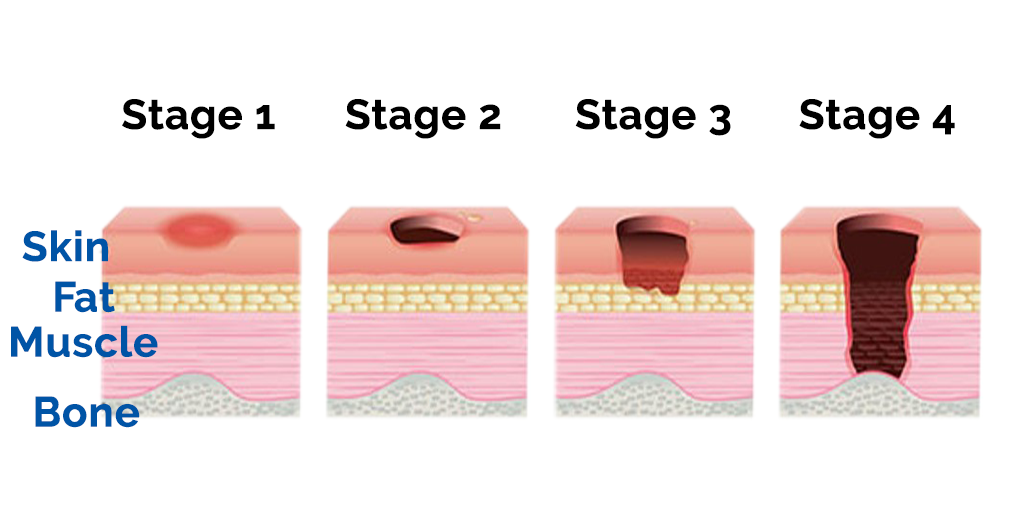What is a deep tissue injury?
Deep tissue injury (DTI) is a form of pressure ulcer or pressure sore. Pressure ulcers are localized areas of tissue damage of necrosis that develop because of the pressure of a bony prominence.[1] A thin blister will form over the surface of the wound bed, sometimes causing local discoloration, which hides the progression of damage to the underlying tissues until the trauma is increasingly problematic and treatment more difficult. Those most at risk of getting pressure ulcers include patients confined to a bed with illness or after surgery, urinary incontinence, and bowel incontinence.[2] The severity of pressure ulcers can vary from inconvenient, with treatment at a basic nursing level, to severe and life-threatening complications, such as blood poisoning.
6 Stages of Pressure Injuries
Pressure injuries are organized into six stages based on the type of tissue visualized or palpated:
-
-
- Stage 1– skin may be painful, but it has no breaks or tears. Skin appearance is red or discolored. Skin temperature is often warmer, and the sore can feel firmer or softer than the tissue surrounding it.
- Stage 2 – skin usually breaks open, wears away, or forms a tender and painful ulcer. The sore can look like an abrasion, a shallow crater in the skin, or a liquid-filled blister. Some skin may be damaged beyond repair or may die.
- Stage 3 – the sore extends into the tissue beneath the skin, forming a small crater. Fat may show in the sore.
- Stage 4– the sore extends into muscle and bone, causing extensive damage. Damage to deeper tissues, tendons, and joints may occur.
- Unstageable– This means that the stage is not clear. In these cases, the base of the sore is covered by a thick layer of other tissue and pus that may be yellow, gray, green, brown, or black. The doctor cannot see the base of the sore to determine the stage.[3]
- Suspected deep tissue injury (sDTI)– when a deep pressure injury is suspected but can’t be confirmed. The area of skin may look purple or dark red, or there may be a blood-filled blister.[4]
-
In the incidence of a deep pressure injury, blood flow to the area is absent or significantly diminished, which causes cell disruption, dematuration of plasma proteins, and hypertonicity, leading to cellular dehydration and cell death that may be similar to what happens to patients with frostbite.[5] The US national cost of burden of hospital-acquired pressure injury (HAPI) could exceed $26.8 billion; about 59% of the costs are disproportionately attributed to a low rate of Stages 3 and 4 full-thickness wounds, which occupy clinician time and hospital resources.[6] Steps for preventing pressure ulcers include the use of a foam mattress (or one filled with gel or air) and pads placed under the patient to absorb any moisture and keep the skin dry. Soft foam set between body parts that press against each other, or the mattress, can also alleviate the pressure. [7]
Boehringer Labs used this prevention philosophy when developing the CareDry® sponge. Click to learn more about how the CareDry® system can help prevent pressure ulcers and deep tissue injury.
[1] Wake WT. Pressure ulcers: what clinicians need to know. Perm J. 2010;14(2):56-60. doi:10.7812/tpp/09-117
[2] https://www.nhs.uk/conditions/pressure-sores/
[3] “Pressure Injuries: Stages.” Healthwise Staff. Medical Review: E. Gregory Thompson MD – Internal Medicine & Adam Husney MD – Family Medicine & Kathleen Romito MD – Family Medicine & Margaret Doucette DO – Physical Medicine and Rehabilitation, Wound Care, Hyperbaric Medicine
[4] “Pressure Injuries: Stages.” Healthwise Staff. Medical Review: E. Gregory Thompson MD – Internal Medicine & Adam Husney MD – Family Medicine & Kathleen Romito MD – Family Medicine & Margaret Doucette DO – Physical Medicine and Rehabilitation, Wound Care, Hyperbaric Medicine
[5] Smart, Hiske MA, RN, PG Dip(UK), IIWCC (Toronto) Deep Tissue Injury, Advances in Skin & Wound Care: February 2013 – Volume 26 – Issue 2 – p 56-58 doi: 10.1097/01.ASW.0000426712.72787.f3
[6] Padula WV, Delarmente BA. The national cost of hospital-acquired pressure injuries in the United States. Int Wound J. 2019 Jun;16(3):634-640. doi: 10.1111/iwj.13071. Epub 2019 Jan 28. PMID: 30693644; PMCID: PMC7948545.
[7] https://medlineplus.gov/ency/patientinstructions/000147.htm
*image taken from https://www.ncbi.nlm.nih.gov/pmc/articles/PMC2912087/
Back to Blog


